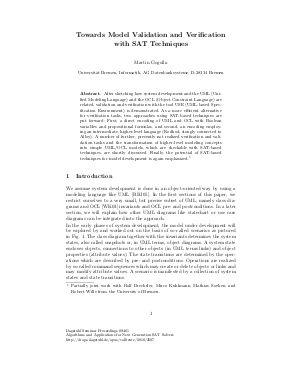Towards Model Validation and Verification with SAT Techniques
Author Martin Gogolla
-
Part of:
Volume:
Dagstuhl Seminar Proceedings, Volume 9461
Part of: Series: Dagstuhl Seminar Proceedings (DagSemProc) - License:
 Creative Commons Attribution 4.0 International license
Creative Commons Attribution 4.0 International license
- Publication Date: 2010-03-17
File

PDF
DagSemProc.09461.6.pdf
- Filesize: 269 kB
- 11 pages
Document Identifiers
Subject Classification
Keywords
- UML
- OCL
- Invariant
- Pre- and postcondition
- Model validation
- Model verification
Metrics
- Access Statistics
-
Total Accesses (updated on a weekly basis)
0PDF Downloads0Metadata Views
Abstract
After sketching how system development and the UML (Unified Modeling Language) and the OCL (Object Constraint Language) are related, validation and verification with the tool USE (UML-based Specification Environment) is demonstrated. As a more efficient alternative for verification tasks, two approaches using SAT-based techniques are put forward: First, a direct encoding of UML and OCL with Boolean variables and propositional formulas, and second, an encoding employing an intermediate, higher-level language (KODKOD, stongly connected to ALLOY). A number of further, presently not realized verification and validation tasks and the transformation of higher-level modeling concepts into simple UML/OCL models, which are checkable with SAT-based techniques, are shortly discussed. Finally, the potential of SAT-based techniques for model development is again emphasized.
Cite As Get BibTex
Martin Gogolla. Towards Model Validation and Verification with SAT Techniques. In Algorithms and Applications for Next Generation SAT Solvers. Dagstuhl Seminar Proceedings, Volume 9461, pp. 1-11, Schloss Dagstuhl – Leibniz-Zentrum für Informatik (2010)
https://doi.org/10.4230/DagSemProc.09461.6
BibTex
@InProceedings{gogolla:DagSemProc.09461.6,
author = {Gogolla, Martin},
title = {{Towards Model Validation and Verification with SAT Techniques}},
booktitle = {Algorithms and Applications for Next Generation SAT Solvers},
pages = {1--11},
series = {Dagstuhl Seminar Proceedings (DagSemProc)},
ISSN = {1862-4405},
year = {2010},
volume = {9461},
editor = {Bernd Becker and Valeria Bertacoo and Rolf Drechsler and Masahiro Fujita},
publisher = {Schloss Dagstuhl -- Leibniz-Zentrum f{\"u}r Informatik},
address = {Dagstuhl, Germany},
URL = {https://drops.dagstuhl.de/entities/document/10.4230/DagSemProc.09461.6},
URN = {urn:nbn:de:0030-drops-25078},
doi = {10.4230/DagSemProc.09461.6},
annote = {Keywords: UML, OCL, Invariant, Pre- and postcondition, Model validation, Model verification}
}
